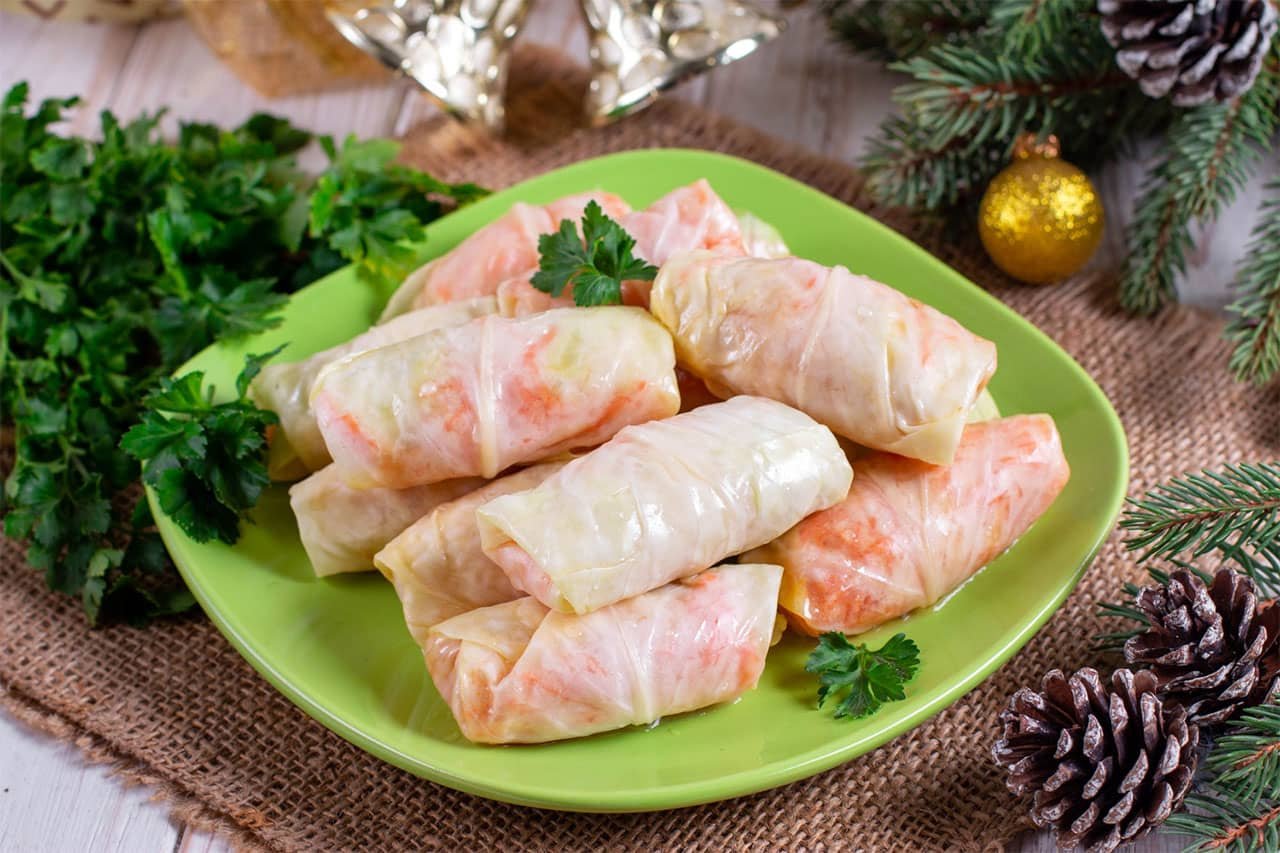This sour cabbage leaves recipe will show you how you can make your own sour cabbage leaves at home and used them to make Sarma. These cabbage leaves are cooked with rice, minced meat and onions. Sour cabbage leaves are used to add a nice sour taste to the dish.
These fermented cabbage heads have a tangy taste that has hints of lemon, which will produce the tastiest leaves for making cabbage rolls of any kind. But here is difference to rememeber as many people mistaken them with the sauerkraut made with shredded leaves, that fermented cabbage leaves are no where near as strong as sauerkraut. For more rich flavor you can add whatever spices and herbs you want to the fermenting liquid. As you are using salt in the fermenting process, remember later to not put too much salt when you prepare the sarma, as cabbage leaves will already be salty.
There are many different variations for sour cabbage leaves recipes and they are all going to be good enough to make sour cabbage leaves for your favorite sarma recipes.
Sour Cabbage Leaves Recipe to Try at Home
Cabbage is a leafy vegetable that has been enjoyed for centuries. Fermented sour cabbage leaves are a traditional food in many cultures and have a long history of being used as a natural remedy.
Cabbage is thought to have originated in the Mediterranean region and was first cultivated by the ancient Greeks. The Romans also grew cabbage and ate it both raw and cooked. Cabbage was introduced to northern Europe by the Romans and became a staple food in many countries.
Sour cabbage leaves are a type of fermented food. Fermented foods are made by letting microorganisms, such as bacteria and yeast, break down carbohydrates in the food. This process gives the food a sour taste and a slightly fizzy texture.
Sour cabbage leaves are traditionally eaten in Eastern Europe. They can be used as a condiment or ingredient in dishes such as sauerkraut, soups, and stews. Sour cabbage leaves are high in vitamins A and C, minerals, have anti-inflammatory properties, and they contain probiotic bacteria that can improve gut health.
However, the use of cabbage for its medicinal properties was not firmly established until the beginning of the 18th century when the European doctor, H. B. De Ceuleneer, started publishing work on its beneficial properties.
If you want to try fermented sour cabbage leaves, look for them in your local grocery store or specialty food shop. They should be stored in the refrigerator and will keep for several months. Try this sour cabbage leaves recipe If you want to make your own sour cabbage leaves at home.
Top Health Benefits from Sour Cabbage
Sour cabbage, also known as Sauerkraut, is a beneficial and healthy food, that is becoming increasingly popular. If you have been having a hard time eating your vegetables lately, we have some tips for you that may be able to help you get back on track! But first, let’s take a look at the potential health benefits of sour cabbage, which is one of the healthiest foods you can eat.
The cabbage leave is an amazing vegetable with many positive effects on the body. Implementing cabbage in your diet using this fermented sour cabbage leaves recipe or any other recipe for making sour cabbage leaves will be benefitial for your overall health. Here are some of the health benefits that you can enjoy from eating sour cabbage leaves.
- Rich in vitamins like B, C, E, K, B12
- Boosting your immune system and protect against various diseases
- May help you to lose weight – low in calories and high in fiber
- Help reduce stress
- Creates a healthy gut flora
- Contain a compound called lactic acid, which has been shown to have antibacterial properties
- Good source of dietary fiber, which is important for maintaining a healthy digestive system
- Stronger Bones – vitamin K2 play important role in bone health
- Improves your digestion
- Contain compounds that may also help to prevent cancer

Sour Cabbage Leaves Recipe
Equipment
- 1 Cutting board
- 1 Large jar with tight fitting lid
Ingredients
- 1 whole cabbage head
- 1-2 garlic (peeled and quartered)
- 2 bay leaves (optional)
- ¼ cup sea salt (do not use iodized)
- 1 l water
Instructions
- To start, get rid of the outer cabbage leaves, rinse the cabbage heads well to remove dirt and debris.
- Put the cabbage head on cutting board and use a sharp knife to cut out the core. Try to cut deep enough to remove the whole core.
- Put the cabbage head into a deep jar or container.
- In the whole of the core add salt to better soften the stems.
- In a large pot bring about 1 liter of water to boil and add the rest of the salt, mix together the salt with water and stir well. Roughly 1⅕oz salt to 1 litter which makes this makes a 3.5% concentration.
- Press the cabbage down done to reduce oxygen to a minimum.
- Pour the boiling water into the pot. Close the pot or jar with the lid and make sure it it tight. Shake it and leave it in a room temperature for up to 5 days.
Notes
Explore More Sarma Recipes?
In conclusion, sour cabbage leaves are an excellent way to get the health benefits of cabbage in a convenient, delicious form. With high concentrations of antioxidants and anti-inflammatory agents, sour cabbage leaves can help improve overall health and well-being. They are also low in calories, making them a great option for those looking to lose weight. Sour cabbage leaves are incredibly versatile, so they can be incorporated into any type of meal or eaten as a snack.
Did you make this sour cabbage leaves recipe?
Please let me know how it turned out for you! Leave a comment below and tag @thebalkanrecipes on Instagram and hashtag it #thebalkanrecipes.

